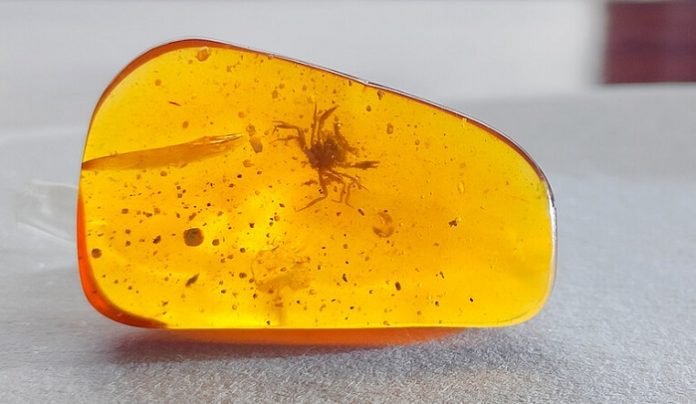
Researchers have discovered the oldest known modern crab — trapped in amber since the time of the dinosaurs.
The 100-million-year-old fossil of the crab, Cretapsara athanata, comes from Myanmar, in Southeast Asia.
It fills a major gap in the fossil record for crabs and resets the timetable for when marine crabs made their way inland.
Yale and Harvard paleontologists led the research, which appears in the journal Science Advances.
“This discovery, in a pristine and spectacular 3D preservation — including fine details of the eyes, antennae, mouthparts, and even the gills — represents the oldest evidence of incursions into land and freshwater by crabs,” said co-lead author Javier Luque, a former Yale researcher who is now a research associate at Harvard.
“Crabs are primarily a marine group that only conquered land and freshwater much later, about 75 to 50 million years ago. They are largely known by bits and pieces of their claws — never in the stunning detail of our new discovery.”
The researchers said the new species, Cretapsara, was most likely neither a marine crab nor a fully terrestrial creature.
Rather, Cretapsara was a freshwater-to-amphibious crab that lived either on the forest floor or in shallow bodies of water near the forest floor.
There, beneath the forest canopy, tree sap covered the small crab and hardened into amber —thus explaining Cretapsara’s exceptional preservation.
“Amber fossils are dominated by insects and plant parts. It is pretty unusual to get water dwelling animals such as crabs trapped in resin from trees,” said co-author Derek Briggs, the G. Evelyn Hutchinson Professor of Earth & Planetary Sciences in Yale’s Faculty of Arts and Sciences. Briggs is also curator of invertebrate paleontology at the Yale Peabody Museum of Natural History.
“This crab is important because it preserves remarkable details, including the delicate gills, which are revealed by scanning the tiny specimen within the amber,” Briggs said.
At 100 million years old, Cretapsara also fills a gap in the fossil record. Molecular evidence, based on the genetics of living crabs, suggests that freshwater crabs first appeared 130 million years ago. Yet the fossil record for modern-looking crabs only went back 50 to 75 million years ago — until now.
“This finding demonstrates that crabs have conquered land and freshwater more than 12 times, independently, since the Cretaceous crab revolution, when crabs diversified worldwide and started evolving the characteristic, crabby-looking body forms typical of most modern crabs today,” Luque said.
Lida Xing of China University of Geosciences is co-lead author of the study.
Support for the research included funding from the Yale Institute for Biospheric Studies, the National Science Foundation, the National Natural Science Foundation of China, the National Geographic Society, the 111 Project, Fundamental Research Funds for Central Universities, and the Natural Sciences and Engineering Research Council of Canada.
Written by Jim Shelton.



